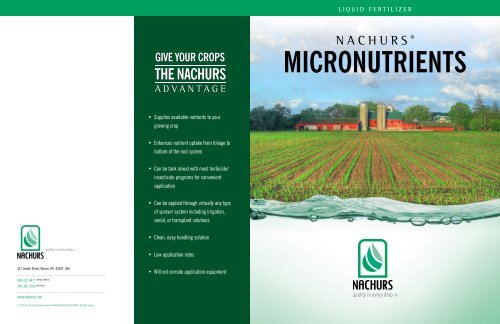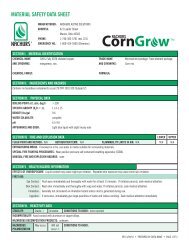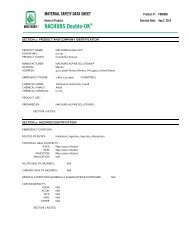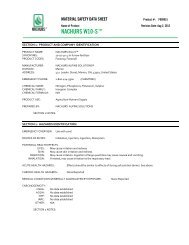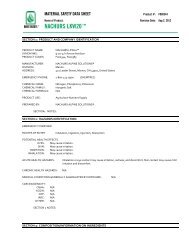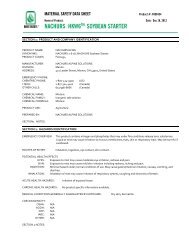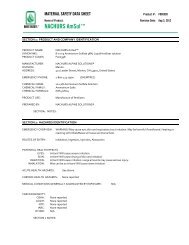Micronutrients Brochure - NACHURS
Micronutrients Brochure - NACHURS
Micronutrients Brochure - NACHURS
Create successful ePaper yourself
Turn your PDF publications into a flip-book with our unique Google optimized e-Paper software.
l i q u i d f e r t i l i z e r<br />
GIVE YOUR CROPS<br />
THE <strong>NACHURS</strong><br />
A D V A N T A G E<br />
N A C H U R S ®<br />
MICRONUTRIENTS<br />
• Supplies available nutrients to your<br />
growing crop<br />
• Enhances nutrient uptake from foliage to<br />
bottom of the root system<br />
• Can be tank mixed with most herbicide/<br />
insecticide programs for convenient<br />
application<br />
• Can be applied through virtually any type<br />
of sprayer system including irrigation,<br />
aerial, or transplant solutions<br />
• Clean, easy handling solution<br />
• Low application rates<br />
421 Leader Street, Marion, OH 43302 USA<br />
• Will not corrode application equipment<br />
800-622-4877<br />
TOLL FREE<br />
740-382-5701 OFFICE<br />
www.nachurs.com<br />
© 2010. Na-Churs Plant Food Company dba <strong>NACHURS</strong> ALPINE SOLUTIONS. All rights reserved.
go with the leader<br />
nachurs<br />
4Highest quality liquid EDTA chelated micronutrients<br />
4Quality, precision placement, seed and foliar safe<br />
4Low impurities<br />
4100% EDTA chelated<br />
4Highly stable<br />
<strong>NACHURS</strong> 100% EDTA chelated micronutrients are<br />
designed to be combined with <strong>NACHURS</strong> liquid starters<br />
and foliars, allowing the product to be placed directly<br />
with the seed at planting time, or on the plant foliage.<br />
<strong>NACHURS</strong> products have a neutral pH and are low<br />
in both salt index and impurities. Placement with<br />
the seed allows the EDTA chelated micronutrients<br />
along with the available phosphorus and potassium<br />
to be taken up at the critical early stages of growth to<br />
maximize yield potential.<br />
<strong>NACHURS</strong> EDTA chelated micronutrients are formulated<br />
to mix with <strong>NACHURS</strong> fertilizers on the plant foliage,<br />
allowing for fast absorption into the plant in a very<br />
short period of time. This rapid uptake at critical<br />
growth stages promotes plant health and increased<br />
yield potential.<br />
<strong>NACHURS</strong> liquid starters and foliars when mixed<br />
with <strong>NACHURS</strong> EDTA chelated micronutrients are<br />
immediately available to the plant during the critical<br />
early stages of growth.<br />
Why use <strong>NACHURS</strong> EDTA CHELATED micronutrients?<br />
Even though micronutrients are required in minute quantities, they are essential for healthy<br />
plant growth and profitable crop production. <strong>NACHURS</strong> EDTA chelated micronutrients provide<br />
an economical source for correcting nutrient deficiencies and improving plant health. <strong>NACHURS</strong><br />
micronutrients are fully chelated and can be used in both foliar and soil applied applications.<br />
<strong>NACHURS</strong> EDTA fully chelated micronutrients are specifically formulated to prevent nutrient<br />
tie up. With <strong>NACHURS</strong> EDTA chelating process, a ring-like structure is placed around the<br />
micronutrient, protecting it from being tied up with the soil or other nutrients, thus ultimate<br />
nutrient availability to the plant is assured, and deficiencies can be corrected.<br />
The stability of <strong>NACHURS</strong> 100% EDTA chelated micronutrients makes them compatible with<br />
most pesticides and won’t settle out or react with other components in <strong>NACHURS</strong> liquid<br />
fertilizers. <strong>NACHURS</strong> fertilizers and micronutrients are banded for accurate placement, and<br />
the micronutrients with remain mobile in the soil.<br />
Micronutrient Responses<br />
Crop Mn B Cu Zn Mo Fe<br />
Corn M L M H L M<br />
Soybeans H L M M M M<br />
Wheat H L H L L L<br />
Canola M H H M L<br />
Alfalfa M H H L M M<br />
Oats H L H L L M<br />
Grass M L L L L H<br />
Barley M L M M L H<br />
Dry Beans H L L H M H<br />
Potatoes H L L M L<br />
Rye L L L L L<br />
Peas H L L L M<br />
Legend: H... High M... Medium L... Low<br />
ARE YOU AWARE OF THE BENEFITS?<br />
What is a chelate?<br />
A chelate is a complex organic<br />
molecule that surrounds the<br />
nutrient ion. Chelates are used<br />
as carriers for micronutrients, to<br />
keep them in solution and protect<br />
them from reactions that cause the<br />
micronutrient to become insoluble<br />
and unavailable to the plant.<br />
THE EDTA DIFFERENCE<br />
Unlike other micronutrient<br />
sources such as complexes,<br />
partial chelates, and natural<br />
organic complexes, <strong>NACHURS</strong><br />
EDTA chelated micronutrients are<br />
100% available to the crop. Other<br />
micro sources contain too little<br />
complexing agent and undergo<br />
major chemical changes, delivering<br />
significantly less micronutrient in<br />
a form available for plant uptake.<br />
While these sources of micros may<br />
offer cost savings at first, they can<br />
actually create deficiencies for lack<br />
of availability.<br />
MICRO FACTS<br />
• <strong>NACHURS</strong> EDTA chelates can be<br />
applied to soil at planting time<br />
or foliar spray applied directly<br />
to the plant.<br />
• Always refer to a soil or tissue<br />
report to determine the<br />
nutrients needed to correct<br />
micronutrient deficiencies.<br />
• Preventing micronutrient<br />
deficiencies in crops is far<br />
better than correcting them<br />
after symptoms appear.<br />
THE ROLE OF MICRONUTRIENTS<br />
Zinc (Zn)<br />
Zinc is necessary for starch formation and proper root development. It is also essential for<br />
seed formation and maturity. The most common nutrient deficiencies include interveinal<br />
chlorosis on older leaves with shortening of the internodal area. This shortening often<br />
results in a short compressed plant with a rosetted appearance.<br />
Manganese (Mn)<br />
Manganese is essential to plants but too much is toxic. Manganese functions in chlorophyll<br />
development and serves as a catalyst in several enzyme systems in the oxidation-reduction<br />
process. Manganese deficiencies are very similar to iron deficiencies and appears in the<br />
younger leaves of the plant first. Color may be pale between the veins of broadleaf plants.<br />
Boron (B)<br />
Boron is vital to the growth and development of the plant. Without adequate Boron, new<br />
growth ceases. It is necessary in the pollination and seed production stages. Boron is<br />
essential for maintaining a balance between sugars and starches. A small amount of<br />
Boron is beneficial to plants but too much can be toxic to plants.<br />
Copper (Cu)<br />
Copper is important as a co-enzyme. It is needed to activate several plant enzymes,<br />
including building and converting amino acids to proteins. Since Copper is an immobile<br />
nutrient, deficiency symptoms usually occur on new growth. Copper deficient plants will<br />
become chlorotic and take on a bleached appearance. New growth may die.<br />
Iron (Fe)<br />
Iron functions as a catalyst in several processes within the plant. It plays a vital role in<br />
the formation of chlorophyll and also functions in the respiratory enzymes. Iron serves in<br />
the transportation of energy in the plant. Iron is also an immobile nutrient and nutrient<br />
deficiencies are usually noticed first in the young leaves. They will first exhibit interveinal<br />
chlorosis which will spread over the entire leaf and turn the leaf white. New growth will<br />
cease and the leaves will die.<br />
Magnesium (Mg)<br />
Magnesium is the key element in the molecule of chlorophyll. It regulates the uptake of<br />
other nutrients in the plant and acts as a carrier of phosphorous in the plant. Deficiencies<br />
usually occur in sandy soils or in soils with extremely high pH. Magnesium deficiencies<br />
cause corn plants to develop light yellow or white appearance between the parallel veins.<br />
Calcium (Ca)<br />
A secondary element in plant nutrition, calcium is needed in the plant to promote early root<br />
formation and growth. Improves general plant vigor and stiffness of stalk. With Calcium<br />
deficiencies, leaves have a wrinkled or crinkled appearance and in some instances, young<br />
leaves may never unfold. Roots are also short and are very bunched.<br />
Talk to your Sales Manager/Agronomist for specific recommendations<br />
N A C H U R S ®<br />
MICRONUTRIENTS<br />
THE nachurs ADVANTAGE


